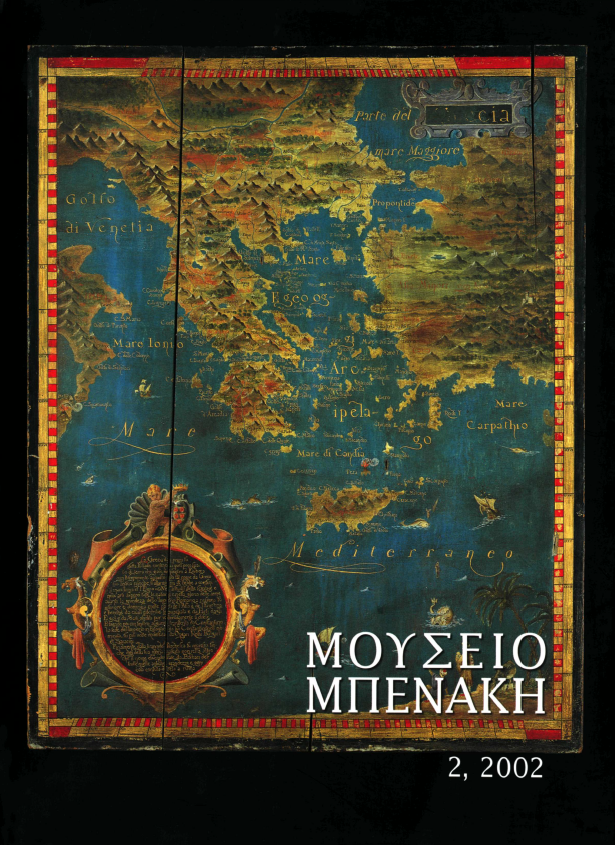An ivory comb with the personifications of Rome and Constantinople
Abstract
The Benaki Museum comb (inv. no. 10287) was acquired in 1925 from the Paris dealers Daguerre, with a stated provenance of Egypt. It belongs to the type of compact combs and has engraved decoration in low relief. On one side is a depiction of the goddess Roma enthroned under a ciborium with spirally fluted columns, wearing a helmet and with a spear in her right hand and an orb in her left. On the other side is the personification of the Tyche of Constantinople, also enthroned under a ciborium, wearing a sleeved chiton and himation. On her head she has a turreted diadem and a peplos which reaches down to her shoulders. She holds a torch in her right hand and a cornucopia in her left. Both thrones have a tall back, a cushion on the seat and a footstool. Though made of ivory, the comb displays the typical features of wooden Coptic combs. All have a rectan-gular form and a compact shape, with a few thick teeth on one of the two narrow sides and numerous thin teeth on the other. In shape it bears a great resemblance to two combs found in excavations in Egypt -one made of ivory and the other of wood- though these are very different stylistically. The presence of the goddess Roma and the Tyche of Constantinople make the Benaki Museum comb unique of its type. The portrayal of Roma has adopted iconographie features dating from the late 4th or early 5 th century, but certain details, such as the ciborium with its baldachin, are found in works of the mid-6th century. The Tyche of Constantinople has specific symbols representative of her role as protectress of the new capital. She wears a turreted crown which has its origin in Hellenistic and early Roman portrayals of the goddess Cybele, but is also found in representations of Constantinople from the early 6th century. The depictions of Roma and Constantinople thus follow models from earliest Christian times, but the closest iconographie parallels are to be found in the 6th century, when the established forms survived only in the provinces, and appear to have been abandoned by the workshops of Constantinople. The allegorical depictions of the two capitals follow models of imperial iconography and no doubt symbolize the prosperity guaranteed in the east and the west by the central state authority and its legitimate representatives in the provinces. An example of these portrayals may perhaps have provided the model for the personifications of the two capitals in the diptych in the Kunsthistorisches Museum in Vienna, produced centuries later and under special cultural conditions. An analysis of the stylistic features of the representations on the comb suggests a cautious dating to the second half of the 6th century. An identical treatment of the facial types, also engraved in low relief, is found in a group of ivory pyxides attributed to Egyptian workshops and dated to the second half of the 6th century. Both iconography and style accord with the probability of the comb having being produced in Egypt. Moreover a fragment of the lid of a bone pyxis, found on the floor of a house in Alexandria and datable to the 6th or 7th century, shows a figure of Dionysos with remarkable similarities to the portraits on the comb. These resemblances are especially valuable as the object has been associated with a large group of bone and ivory shards and unfinished works which display the skill of such workshops in Alexandria at their peak. One of the most important questions concerning the comb, whether it was an object of daily use with ornamentation inspired by the insignia of imperial iconography or a work of art with no special symbolism for its user cannot be answered in the absence of archaeological evidence. The presence of earth between the narrow teeth of the comb merely confirms that it was found in an excavation. The discovery of a painting with a representation of the Tyche of Constantinople in a house in Edfu in Upper Egypt indicates that such personified portrayals are sometimes found even in marginal areas, outside the great cities and at a late date, the first half of the 7th century. The Benaki Museum comb could have been a funeral offering at the grave of a distinguished member of Egyptian society, more specifically from Alexandria, but this is a theory which cannot be confirmed at the present time.
Article Details
- How to Cite
-
Βαραλής Ι. Δ. (2018). An ivory comb with the personifications of Rome and Constantinople. Mouseio Benaki Journal, 2, 71–87. https://doi.org/10.12681/benaki.18189
- Issue
- Vol. 2 (2002)
- Section
- Articles

This work is licensed under a Creative Commons Attribution-NonCommercial-ShareAlike 4.0 International License.
The copyright for articles published in Mouseio Benaki is retained by the author(s), with first publication rights granted to the journal. By virtue of their appearance in this open access journal, articles may be used freely for non-commercial uses, with the exception of the non-granted right to make derivative works, with proper reference to the author(s) and its first publication. The Benaki Museum retains the right to publish, reproduce, publicly display, distribute, and use articles published in Mouseio Benaki in any and all formats and media, either separately or as part of collective works, worldwide and for the full term of copyright. This includes, but is not limited to, the right to publish articles in an issue of Mouseio Benaki, copy and distribute individual reprints of the articles, authorize reproduction of articles in their entirety in another publication of the Benaki Museum, as well as authorize reproduction and distribution of articles or abstracts thereof by means of computerized retrieval systems.


